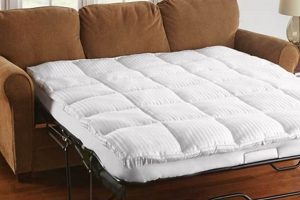The variance in dimensions between a twin and a full mattress constitutes a significant consideration for individuals selecting bedding. A twin mattress, typically measuring approximately 38 inches wide and 75 inches long, provides a compact sleeping surface suitable for single sleepers, children, or smaller bedrooms. Conversely, a full mattress, also known as a double, generally spans 53 inches in width and maintains the same 75-inch length. This increased width offers more space for individual sleepers who desire greater freedom of movement or can accommodate two smaller individuals, albeit with less personal space compared to sleeping alone.
Understanding these dimensional distinctions is crucial for optimizing comfort and space utilization within a bedroom. Selecting the appropriate mattress size can directly influence sleep quality, particularly for individuals who tend to move frequently during the night. Moreover, choosing a mattress that complements the room’s dimensions ensures a harmonious and functional living environment. Historically, the evolution of mattress sizes reflects changing living spaces and evolving preferences for personal sleeping space.
The subsequent sections will delve deeper into the specific applications and advantages of each mattress size, providing a comprehensive comparison to aid in informed decision-making. Factors such as room size, sleeper profile, budget, and intended use case will be explored to facilitate the selection of the optimal mattress dimension.
Key Considerations
Selecting the appropriate mattress size necessitates careful evaluation of individual needs and spatial constraints. Understanding the specific characteristics of each dimension is paramount to ensuring optimal sleep quality and efficient room utilization.
Tip 1: Room Dimensions: Prioritize measuring the available space. A twin mattress is often preferred in smaller rooms, guest rooms, or children’s bedrooms where space is limited. A full mattress requires a larger footprint and is better suited for moderately sized rooms.
Tip 2: Sleeper Profile: Analyze the sleeper’s body size and sleeping habits. Individuals who are taller or tend to move frequently during sleep may benefit from the additional width of a full mattress, even if sleeping alone.
Tip 3: Intended Use: Determine the primary purpose of the mattress. Twin mattresses are commonly used in bunk beds or for single sleepers. Full mattresses are frequently chosen for guest rooms where occasional couples may stay, or for older children/teenagers.
Tip 4: Budget Allocation: Consider the cost implications. Generally, full mattresses are more expensive than twin mattresses due to the increased material requirements.
Tip 5: Long-Term Needs: Project future needs. If a child is currently using a twin mattress, consider whether a full mattress might be more suitable as they grow and require more sleeping space.
Tip 6: Bedding Availability: Verify the availability of appropriate bedding sizes. Twin and full mattresses require specific sheets, comforters, and other bedding accessories. Ensure these items are readily accessible and fit the chosen mattress dimensions.
Adhering to these considerations facilitates a well-informed decision regarding mattress dimensions. The correct choice contributes to both comfort and spatial optimization within the sleeping environment.
The subsequent section will offer a concluding overview, consolidating the key points discussed to provide a comprehensive perspective.
1. Width differential
The width differential between twin and full mattresses represents the most salient dimension contributing to their overall size disparity. This dimensional divergence, typically 15 inches, dictates the amount of lateral space available to the sleeper and profoundly influences the selection process. The increased width of a full mattress, compared to a twin, directly affects the degree of freedom of movement afforded to an individual during sleep, potentially mitigating discomfort associated with restricted space or restless sleeping patterns. For instance, an adult sleeper who frequently changes position during the night is likely to experience greater comfort on a full mattress due to the expanded width. The twin mattress, conversely, may prove sufficient for smaller individuals or children who require less lateral space.
This “Width differential” serves as a key factor in determining the appropriateness of a mattress for specific applications. Consider a small apartment bedroom where maximizing floor space is paramount; a twin mattress may be the more pragmatic choice. Conversely, a guest room designed to accommodate both single individuals and couples would benefit from the enhanced width of a full mattress. The dimensional disparity also influences the selection of bedding; sheets and comforters intended for a twin mattress will invariably be incompatible with a full mattress. Furthermore, the “Width differential” has a direct impact on manufacturing costs, with full mattresses requiring greater material input and correspondingly higher price points.
In summation, the width differential is not merely a dimensional attribute; it is a critical determinant shaping the functional characteristics and suitability of twin and full mattresses for diverse scenarios. Understanding its implications is paramount to making an informed decision that aligns with individual sleeping preferences, spatial constraints, and budgetary considerations. Disregarding this factor can lead to compromised sleep quality and inefficient utilization of available space.
2. Room suitability
The degree to which a mattress dimension complements the overall space within a room constitutes a critical element in bedroom design. Evaluating room dimensions in conjunction with the variance between twin and full mattress sizes is paramount for ensuring functional and aesthetically pleasing sleeping environments.
- Spatial Harmony
Spatial harmony concerns the proportional relationship between furniture size and room volume. A full mattress, while offering increased sleeping space, can overwhelm smaller rooms, restricting movement and creating a sense of confinement. Conversely, a twin mattress may appear diminutive in a larger room, potentially diminishing the room’s aesthetic appeal. Balancing mattress size with room dimensions is essential for achieving a harmonious and balanced spatial arrangement.
- Traffic Flow Optimization
Traffic flow, or the ease of movement within a room, is directly impacted by mattress size. A full mattress occupies more floor space than a twin, potentially impeding passage and hindering access to other furniture or closet space. In constrained spaces, a twin mattress facilitates more efficient traffic flow, enhancing the room’s functionality. Careful consideration of traffic patterns is crucial when selecting a mattress size to optimize maneuverability and minimize spatial obstructions.
- Ancillary Furniture Integration
Ancillary furniture, such as nightstands, dressers, and desks, requires sufficient surrounding space to ensure usability and prevent overcrowding. A full mattress, due to its increased dimensions, reduces the available space for these accompanying furnishings. A twin mattress allows for greater flexibility in furniture placement, enabling a more comprehensive and functional bedroom design. The ability to integrate ancillary furniture effectively contributes to the overall usability and comfort of the sleeping environment.
- Perceived Room Size
Perceived room size, a psychological element, refers to the subjective impression of spaciousness. A full mattress can visually compress a smaller room, creating a sense of claustrophobia. A twin mattress, by occupying less visual space, can enhance the perception of spaciousness, particularly in confined areas. Optimizing perceived room size contributes to a more comfortable and relaxing atmosphere, positively influencing psychological well-being.
In conclusion, room suitability, as it relates to the dimensional variance between twin and full mattresses, extends beyond mere physical accommodation. It encompasses spatial harmony, traffic flow optimization, ancillary furniture integration, and perceived room size. These interrelated factors collectively determine the functionality and aesthetic appeal of the bedroom, highlighting the importance of careful deliberation when selecting a mattress dimension.
3. Individual sleeper space
The concept of individual sleeper space is intrinsically linked to the dimensional variance between twin and full mattresses. The difference in width, approximately 15 inches, directly dictates the amount of personal space available to a sleeper. This has a direct effect on comfort, particularly for individuals who are restless sleepers or require more room to stretch and move during sleep. For example, an adult experiencing frequent tossing and turning may find the restricted width of a twin mattress inhibiting, leading to disrupted sleep. Conversely, a full mattress provides increased lateral space, allowing for greater freedom of movement and a potentially more restful sleep experience. The practical significance of understanding this connection lies in the ability to make informed decisions regarding mattress selection based on individual sleep habits and preferences.
The importance of adequate individual sleeper space also extends beyond mere comfort. Insufficient space can contribute to feelings of confinement and anxiety, especially for individuals who are sensitive to physical limitations. This can lead to increased stress and decreased sleep quality. Furthermore, inadequate space can impact sleep quality by causing the sleeper to adopt awkward or unnatural sleeping positions to compensate for the lack of room, potentially leading to muscle soreness and joint pain. In contrast, sufficient space promotes a sense of relaxation and security, facilitating more natural and comfortable sleep postures. For instance, a taller individual may find that their arms or legs hang off the edge of a twin mattress, leading to discomfort and interrupted sleep. A full mattress, with its increased width, can eliminate this problem and provide a more accommodating sleeping surface.
In summary, the dimensional difference between twin and full mattresses is not merely a matter of size; it directly impacts the availability of individual sleeper space, which has profound consequences for comfort, sleep quality, and overall well-being. While a twin mattress may be sufficient for certain individuals or spatial constraints, the increased width of a full mattress offers tangible benefits in terms of freedom of movement and enhanced sleeping comfort. Recognizing this connection is crucial for making informed decisions regarding mattress selection and optimizing the sleeping environment. The challenge lies in balancing the need for individual sleeper space with considerations such as room size and budgetary constraints.
4. Cost variation
The dimensional variance between twin and full mattresses directly influences production costs, which subsequently impacts retail pricing. The increased material requirements for a full mattress, relative to a twin, result in a tangible price disparity. This “Cost variation” is a significant consideration for consumers when selecting bedding and allocating budget.
- Raw Material Consumption
The primary driver of cost variation stems from the quantity of raw materials utilized. A full mattress, approximately 15 inches wider than a twin, necessitates a proportionally larger volume of foam, springs, fabric, and other components. This increased material consumption directly translates to higher manufacturing expenses. For example, if a cubic foot of memory foam costs $X, the additional cubic feet required for a full mattress inevitably increase the overall production cost.
- Manufacturing Complexity
While the manufacturing process for twin and full mattresses is generally similar, the larger dimensions of a full mattress can introduce minor complexities. These complexities may include increased handling requirements during assembly and higher waste percentages due to potential material defects or cutting errors. The cumulative effect of these subtle manufacturing challenges can contribute to the cost differential. As an illustration, automated cutting machines may require recalibration to accommodate the larger dimensions of a full mattress, adding time and cost to the manufacturing process.
- Shipping and Handling Costs
Larger dimensions translate to increased shipping and handling costs. Full mattresses occupy more space during transportation, leading to higher freight charges for manufacturers and retailers. Additionally, the increased weight of a full mattress can increase handling costs at various stages of the supply chain, from factory to consumer. For example, a trucking company may charge a higher rate for shipping full mattresses due to their larger volume and weight, which affects the overall cost.
- Market Demand and Pricing Strategies
Beyond production costs, market demand and retailer pricing strategies also influence the final price. If full mattresses are in higher demand than twin mattresses, retailers may apply higher markups, further exacerbating the cost difference. Promotional discounts and seasonal sales can also affect the relative price advantage of one size over another. As an example, a retailer may offer a larger discount on twin mattresses to clear inventory, temporarily reducing the cost differential between the two sizes.
The interrelated effects of material consumption, manufacturing complexity, shipping expenses, and market forces contribute to the price variance between twin and full mattresses. Understanding these factors enables consumers to make informed purchasing decisions based on budgetary constraints and specific needs. The choice ultimately involves balancing the desired sleeping space with the associated cost implications.
5. Bedding options
The dimensional variance between twin and full mattresses directly necessitates distinct bedding options. This size discrepancy fundamentally determines the compatibility of sheets, comforters, duvet covers, and other related accessories. Attempting to use bedding designed for a twin mattress on a full mattress, or vice versa, results in improper fit, compromised comfort, and diminished aesthetic appeal. Therefore, understanding the specific bedding requirements associated with each mattress size is crucial for ensuring optimal functionality and longevity of both the mattress and its accompanying accessories. For example, utilizing a twin-sized fitted sheet on a full-sized mattress will inevitably lead to insufficient coverage, causing the sheet to detach from the corners and rendering it ineffective. Conversely, using a full-sized sheet on a twin mattress results in excess fabric that bunches up, creating discomfort and detracting from the bed’s overall appearance. The “Bedding options” thus becomes an integral consideration when evaluating the practical implications of the “difference between twin and full mattress size”.
The relationship between mattress size and bedding availability extends beyond mere dimensional compatibility. Material composition, thread count, and construction quality also contribute to the overall comfort and durability of bedding. While a variety of “Bedding options” exist for both twin and full mattresses, consumers must consider these factors to ensure optimal sleep quality and long-term value. For instance, high-quality cotton sheets with a high thread count offer superior breathability and softness, enhancing the sleeping experience regardless of mattress size. Conversely, inexpensive, low-quality sheets may deteriorate quickly, requiring frequent replacement. Moreover, specific bedding features, such as deep pockets on fitted sheets, are essential for accommodating thicker mattresses or mattresses with added toppers. Selecting appropriate “Bedding options” also involves considering seasonal variations. Lightweight linen sheets are well-suited for warm weather, while heavier flannel sheets provide added warmth during colder months.
In summary, the dimensional variance between twin and full mattresses necessitates the selection of size-appropriate “Bedding options”. This decision impacts not only comfort and aesthetics but also the longevity and functionality of both the mattress and its accompanying accessories. Considerations such as material composition, thread count, construction quality, and seasonal appropriateness should inform the selection process. Ignoring the relationship between mattress size and “Bedding options” can lead to compromised sleep quality and unnecessary expenses. The practical significance of this understanding lies in the ability to make informed purchasing decisions that optimize the sleeping environment and ensure long-term satisfaction.
6. Weight capacity
The specified “Weight capacity” of a mattress is intrinsically linked to its dimensions, particularly when considering the “difference between twin and full mattress size.” This parameter defines the maximum load a mattress can sustainably support without compromising structural integrity or long-term performance. Exceeding this limit can result in premature wear, sagging, and diminished support, ultimately affecting sleep quality.
- Support System Resilience
The internal support system of a mattress, typically comprising springs, foam layers, or a hybrid combination, is designed to distribute weight evenly across its surface. A full mattress, with its larger surface area, generally incorporates a more robust support system than a twin mattress to accommodate potentially greater weight. The density and arrangement of coils in an innerspring mattress, or the density and composition of foam layers in a foam mattress, are critical factors influencing weight capacity. For example, a full-sized mattress designed for heavier individuals may utilize thicker gauge coils and higher-density foam to prevent premature sagging. The correlation lies in the need for the support system’s resilience to scale with the mattress size to ensure consistent performance across its surface.
- Material Composition and Density
The inherent “Weight capacity” of a mattress is also determined by the composition and density of the materials used in its construction. High-density foams and reinforced coil systems offer greater resistance to compression and deformation under load. A full mattress, intended for potentially multiple occupants or a single heavier individual, often incorporates these enhanced materials to withstand increased stress. Consider the difference between a basic foam mattress intended for a child and a hybrid mattress designed for adults; the latter will invariably utilize higher-density foams and a more robust coil system to support greater weight without compromising structural integrity. The selection of materials directly influences the “Weight capacity” and long-term durability of the mattress relative to its dimensions.
- Edge Support and Reinforcement
Edge support refers to the structural reinforcement along the perimeter of the mattress, designed to prevent sagging or collapse when weight is applied near the edges. A full mattress, due to its larger size and potential for multiple sleepers, benefits significantly from robust edge support to maintain consistent support across the entire sleeping surface. Without adequate edge support, the edges of the mattress may compress prematurely, leading to discomfort and reduced usable sleeping area. The implementation of reinforced coils or high-density foam along the perimeter of a full mattress effectively distributes weight and prevents edge collapse, particularly important for couples who may utilize the entire surface area. This feature highlights the relationship between mattress size, “Weight capacity”, and edge support requirements.
- Intended User Profile
The intended user profilesingle sleeper versus multiple sleepers, lighter individual versus heavier individual(s)plays a pivotal role in determining the appropriate mattress size and associated “Weight capacity.” A twin mattress, primarily intended for a single, typically lighter, individual, may have a lower maximum “Weight capacity” compared to a full mattress designed to accommodate two adults or a single heavier individual. Exceeding the recommended “Weight capacity” can accelerate wear and tear, compromising support and comfort. For instance, placing two adults on a twin mattress designed for a single child will likely exceed its “Weight capacity,” leading to premature sagging and reduced sleep quality. Matching the mattress size and “Weight capacity” to the intended user profile is crucial for ensuring long-term performance and optimal sleep conditions.
In summary, the “difference between twin and full mattress size” directly impacts the required “Weight capacity” due to variations in surface area and intended use. The support system, material composition, edge support, and the intended user all play significant roles in determining an appropriate weight limit, which must be considered to ensure the mattress performs optimally and maintains its structural integrity over its lifespan. Disregarding these factors can lead to diminished comfort, reduced support, and premature mattress failure.
7. Longevity needs
The anticipated lifespan of a mattress, or “Longevity needs,” is intricately linked to its dimensions, rendering the “difference between twin and full mattress size” a salient consideration. Choosing a mattress size that aligns with projected usage patterns and structural durability contributes to long-term cost-effectiveness and sustained sleep quality.
- Frequency of Use
The frequency with which a mattress is used directly impacts its lifespan. A guest room mattress, utilized infrequently, will likely exhibit slower wear compared to a master bedroom mattress used nightly. Therefore, a twin mattress intended for occasional use may suffice, while a full mattress used daily necessitates a more robust construction to meet “Longevity needs.” For example, a full mattress used in a rental property with frequent tenant turnover requires a more durable design than a twin mattress in a seldom-used vacation home.
- Occupant Weight and Distribution
The weight of the occupant, or occupants, significantly influences mattress durability. A full mattress designed to accommodate two individuals must withstand a greater load than a twin mattress intended for a single sleeper. The distribution of weight is also critical; uneven weight distribution can lead to localized sagging and premature wear. Reinforced edge support, for instance, can mitigate sagging along the perimeter of a full mattress. The consideration for occupant weight and distribution is critical to meeting “Longevity needs” of a given mattress dimension.
- Material Degradation Resistance
The inherent resistance of mattress materials to degradation directly affects its lifespan. High-density foams, tempered steel coils, and durable fabric covers contribute to increased “Longevity.” A full mattress, with its larger surface area and potential for greater stress, benefits from materials exhibiting superior resistance to compression, abrasion, and moisture. For example, a latex mattress generally exhibits greater resistance to degradation than a traditional innerspring mattress, contributing to a longer lifespan. Material selection is a critical factor in ensuring the “Longevity needs” of any mattress size are met.
- Maintenance and Care Practices
Adherence to recommended maintenance and care practices significantly extends mattress lifespan. Regular rotation, vacuuming, and the use of a mattress protector can minimize wear and tear, preserving structural integrity. Neglecting these practices, conversely, accelerates degradation, shortening the mattress’s usable life. While proper care benefits all mattress sizes, it is particularly crucial for full mattresses, which are often subjected to greater stress and usage. Consistent maintenance contributes to achieving the desired “Longevity needs”, irrespective of the “difference between twin and full mattress size.”
The interrelationship between frequency of use, occupant weight, material degradation resistance, and maintenance practices collectively determines the lifespan of a mattress. When considering the “difference between twin and full mattress size”, evaluating these factors in conjunction with projected usage patterns enables a more informed decision, optimizing long-term value and ensuring sustained sleep quality. The desired longevity should factor heavily in the initial selection process.
Frequently Asked Questions
The following addresses frequently encountered inquiries regarding dimensional distinctions between twin and full-size mattresses, providing objective information for informed decision-making.
Question 1: What are the precise dimensional differences between a twin and a full mattress?
A twin mattress typically measures 38 inches wide by 75 inches long. A full mattress, also known as a double, measures 53 inches wide by 75 inches long. The primary difference is a 15-inch increase in width.
Question 2: Is a full mattress suitable for two adults?
While a full mattress can accommodate two adults, it provides significantly less individual sleeping space compared to larger mattress sizes such as a queen or king. The available space per person is comparable to that of a twin bed. Therefore, comfort levels may vary depending on individual preferences and sleep habits.
Question 3: Does the increased width of a full mattress automatically equate to increased weight capacity?
Not necessarily. Weight capacity is determined by the internal construction and materials of the mattress, not solely by its dimensions. A full mattress designed for a single heavier individual may have a higher weight capacity than a cheaply constructed full mattress intended for two lighter individuals. Always consult the manufacturer’s specifications.
Question 4: Are twin and full mattresses equally durable?
Durability is primarily a function of material quality and construction techniques, not inherently tied to mattress size. However, a full mattress, due to its larger surface area, may be subject to greater stress and require more robust construction to maintain its structural integrity over time.
Question 5: Can twin-size bedding be used on a full mattress or vice versa?
No. The dimensional disparity between twin and full mattresses necessitates distinct bedding sizes. Attempting to use bedding designed for one size on the other will result in improper fit and compromised comfort.
Question 6: Does the cost difference between twin and full mattresses solely reflect the increased material usage?
While increased material usage is a primary driver of cost variation, other factors such as manufacturing complexity, shipping expenses, and market demand also contribute to the price difference. Retailer pricing strategies further influence the final cost to the consumer.
In summary, understanding the dimensional differences, weight capacities, and appropriate bedding options is crucial when selecting between a twin and a full mattress. These considerations directly impact comfort, durability, and overall satisfaction.
The next section will present a comparative analysis table, summarizing the key features and specifications of twin and full mattresses.
Difference Between Twin and Full Mattress Size
The foregoing analysis underscores that the dimensional disparity, or “difference between twin and full mattress size,” represents a fundamental consideration in bedding selection. This variance impacts room suitability, individual sleeper space, budgetary allocations, bedding options, weight capacity parameters, and projected longevity. A judicious evaluation of these interconnected factors is essential to align mattress choice with individual needs and spatial constraints. Ignoring the dimensional implications can lead to compromised sleep quality, inefficient space utilization, and diminished long-term value.
Therefore, a thorough assessment of the presented information is encouraged prior to purchase. A carefully considered decision, accounting for all relevant variables, will contribute to a more comfortable and functional sleeping environment, ultimately enhancing overall well-being. The selection process should transcend superficial preference, demanding a deliberate alignment with practical considerations for sustained satisfaction.


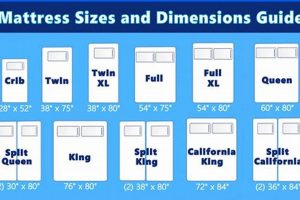
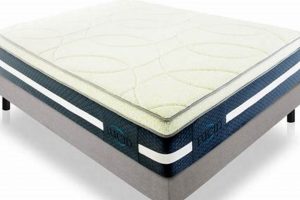
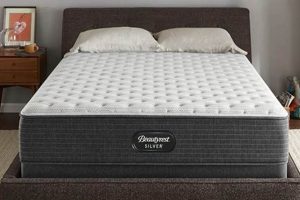
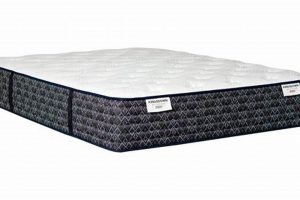
![Best Plush Full Size Mattress [Guide] For Comfort Sleep Organic & Natural Mattress Buyer’s Guide: Non-Toxic Sleep Solutions Best Plush Full Size Mattress [Guide] For Comfort Sleep | Organic & Natural Mattress Buyer’s Guide: Non-Toxic Sleep Solutions](https://mattressworldpa.com/wp-content/uploads/2025/07/th-2793-300x200.jpg)
